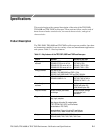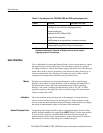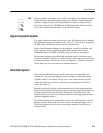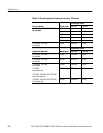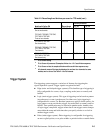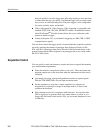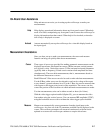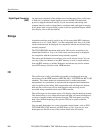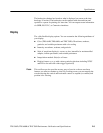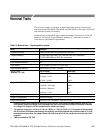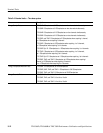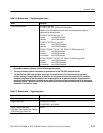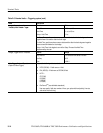
Specifications
2–8
TDS 500D, TDS 600B & TDS 700D Performance Verification and Specifications
An important component of the multiprocessor architecture of this oscilloscope
is Tektronix’ proprietary digital signal processor, the DSP. This dedicated
processor supports advanced analysis of your waveforms when doing such
compute-intensive tasks as interpolation, waveform math, and signal averaging.
It also teams with a custom display system to deliver specialized display modes
(See Display, later in this description).
Storage
Acquired waveforms may be saved in any of four nonvolatile REF (reference)
memories or on a 3.5 inch, DOS 3.3-or-later compatible disk. Any or all of the
saved waveforms may be displayed for comparison with the waveforms being
currently acquired.
The TDS 500D/700D instrument with option 2M can save waveforms to an
internal hard disk drive. Any or all of the saved waveforms may be displayed
for comparison with the waveforms being currently acquired.
The source and destination of waveforms to be saved may be chosen. You can
save any of the four channels to any REF memory or move a stored reference
from one REF memory to another. Reference waveforms may also be written
into a REF memory location via the GPIB interface.
I/O
The oscilloscope is fully controllable and capable of sending and receiving
waveforms over the GPIB interface (IEEE Std 488.1–1987/IEEE Std 488.2–1987
standard). This feature makes the instrument ideal for making automated
measurements in a production or research and development environment that
calls for repetitive data taking. Self-compensation and self-diagnostic features
built into the oscilloscope to aid in fault detection and servicing are also
accessible using commands sent from a GPIB controller.
The oscilloscope can also output copies of its display using the hardcopy feature.
This feature allows you to output waveforms and other on-screen information to
a variety of graphic printers and plotters from the TDS front panel, providing
hard copies without requiring you to put the TDS into a system-controller
environment.
You can make hardcopies in a variety of popular output formats, such as PCX,
TIFF, BMP, RLE, EPS, Interleaf, and EPS mono or color. You can also save
hardcopies in a disk file in any of the formats listed in the I/O section.
Digital Signal Processing
(DSP)




